Characteristics of First-Generation Students Receiving College Counseling
First-generation college students (i.e., those who are the first in their family to attend college) make up nearly 1 in 4 clients presenting to college counseling centers in the United States (Center for Collegiate Mental Health, 2024). First-generation students often face challenges and risk factors that impede academic success, such as financial concerns, lack of familiarity with higher education systems, and complex emotional reactions to being the first in their family to receive higher education (Covarrubias et al., 2021). Conversely, many also bring strengths that can be leveraged in academic and mental health treatment settings to foster resilience, including diverse life experiences (Ives & Castillo-Montoya, 2020). In terms of mental health, general student body surveys have produced mixed results in terms of how first-generation students compare to continuing-generation students (Rockwell & Kimle, 2023; Soria et al., 2022). However, differences in demographic and clinical characteristics between first-generation and continuing-generation students who seek treatment in college counseling have not been reported on a national level. A better understanding of first-generation students’ characteristics when they present to counseling could help clinicians and administrators better serve students within this population. As such, this blog compared the following characteristics between first-generation and continuing-generation students who sought treatment at college counseling centers nationally:
- Demographic variables and financial stress
- Mental health treatment histories
- Presenting concerns assessed by clinicians
- Mental health symptoms
To address these comparisons, we utilized data from 28,244 clients (6,396 first-generation and 21,848 continuing-generation) who received counseling services at 49 UCCs during the 2022-2023 academic year. Clients self-reported demographic data, treatment history, and mental health symptoms at their first counseling appointment using the Standardized Data Set (SDS) and Counseling Center Assessment of Psychological Symptoms-34 (CCAPS-34).Clinicians provided their assessment of clients’ primary or topmost presenting concerns on the Clinician Index of Client Concerns (CLICC) after their first counseling session with students.
Demographic Variables (First vs. Continuing Generation Students)
First-generation clients’ gender identities were generally similar to continuing-generation clients. A slightly higher percentage of first-generation clients identified as cisgender women and a lower proportion identified as cisgender men.
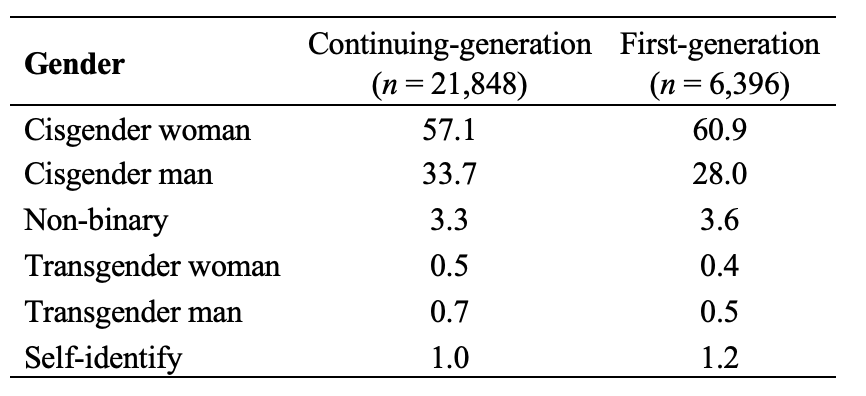
First-generation clients were somewhat more diverse than continuing-generation clients in terms of sexual orientation. Specifically, a lower percentage identified as heterosexual, and slightly higher percentages identified with other diverse sexual orientations.
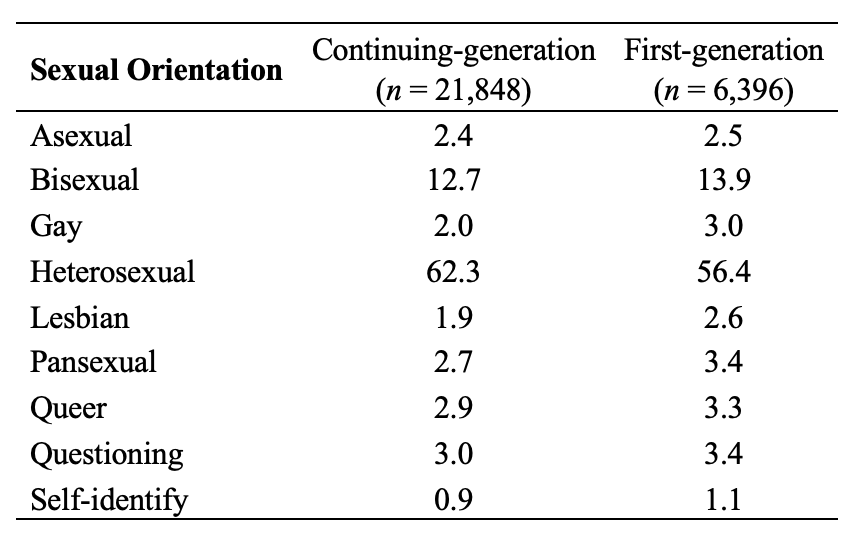
Compared to continuing-generation clients, a substantially larger proportion of first-generation clients identified with minoritized racial/ethnic groups. In particular, those who were first-generation were more likely to identify as Hispanic/Latino/a and African American/Black and less likely to identify as White.
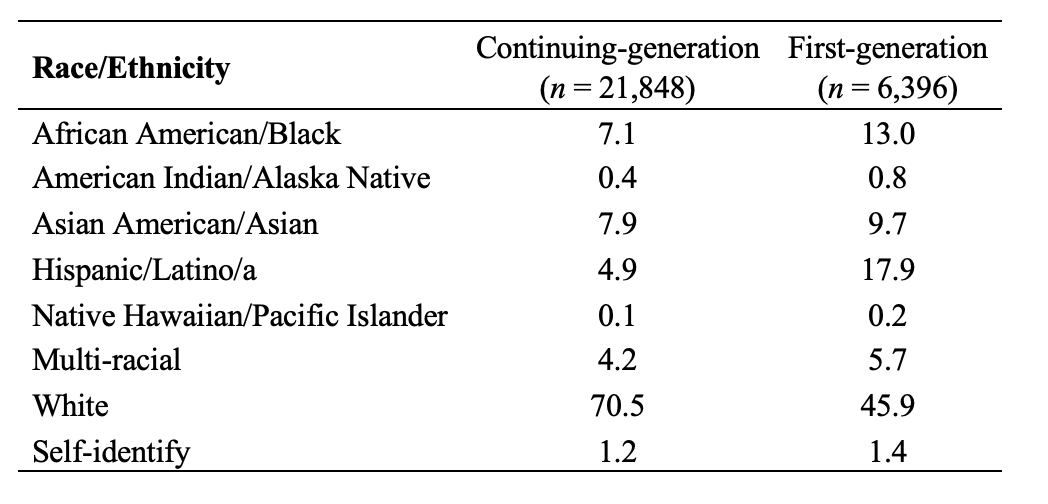
On average, first-generation clients reported more frequent financial stress and were slightly older than continuing-generation clients.

Mental Health Treatment Histories (First vs. Continuing Generation Students)
Over half of both first- and continuing-generation clients reported prior counseling. Compared to continuing-generation clients, a slightly lower percentage of first-generation clients reported a history of counseling or psychiatric medication, and a slightly higher percentage reported a history of psychiatric hospitalization.
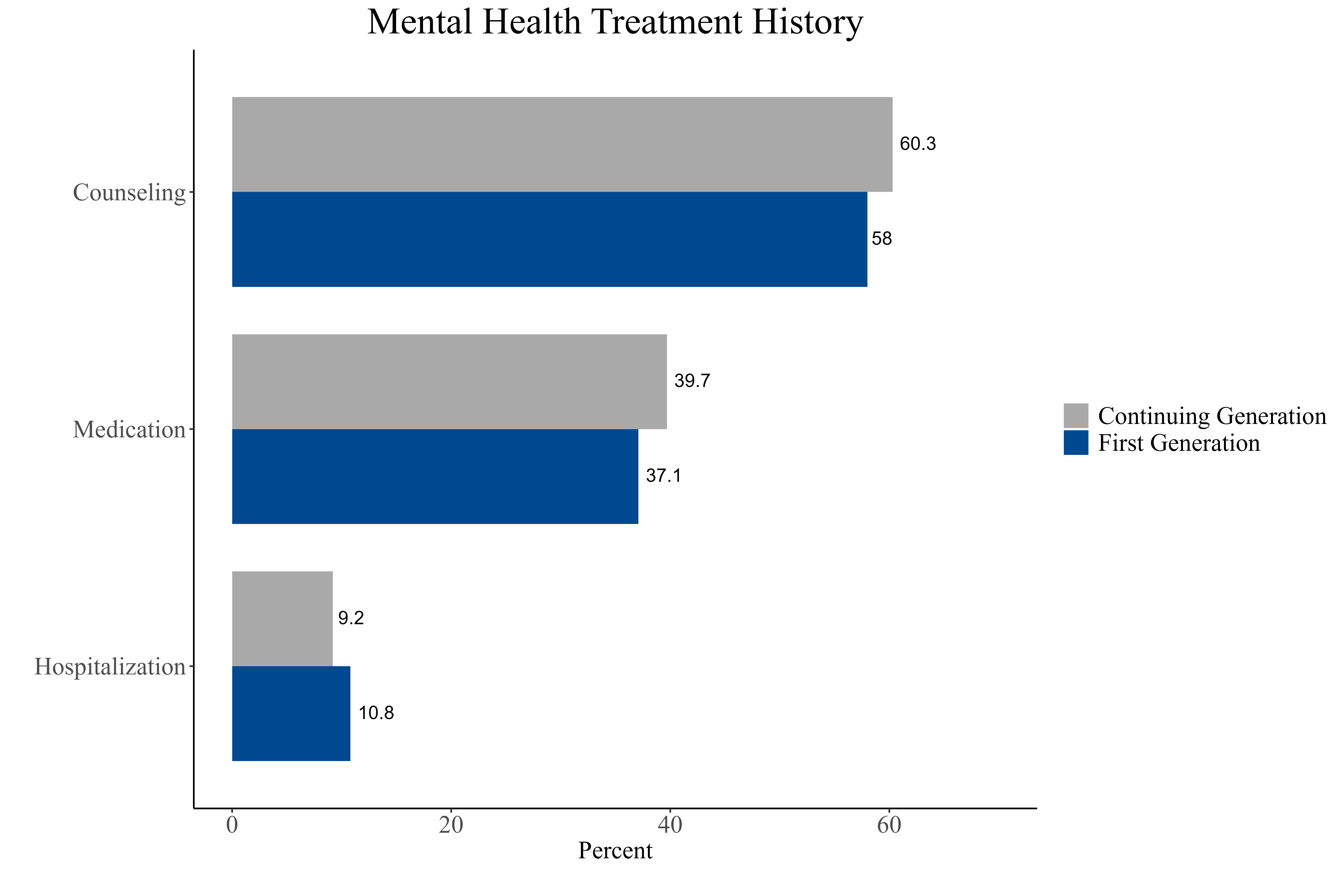
Presenting Concerns Assessed by Clinicians (First vs. Continuing Generation Students)
After their first appointments with clients, clinicians most frequently identified depression and generalized anxiety as clients’ primary (topmost) presenting concerns regardless of first-generation student status. However, clinicians were substantially more likely to identify trauma and family-related concerns as being primary for first-generation compared to continuing-generation clients. Additionally, clinicians were less likely to assess first-generation clients with generalized anxiety as their top concern compared to continuing-generation clients. Smaller differences were observed across other presenting problems (e.g., first-generation clients were slightly more likely to be assessed as presenting with depression or stress).
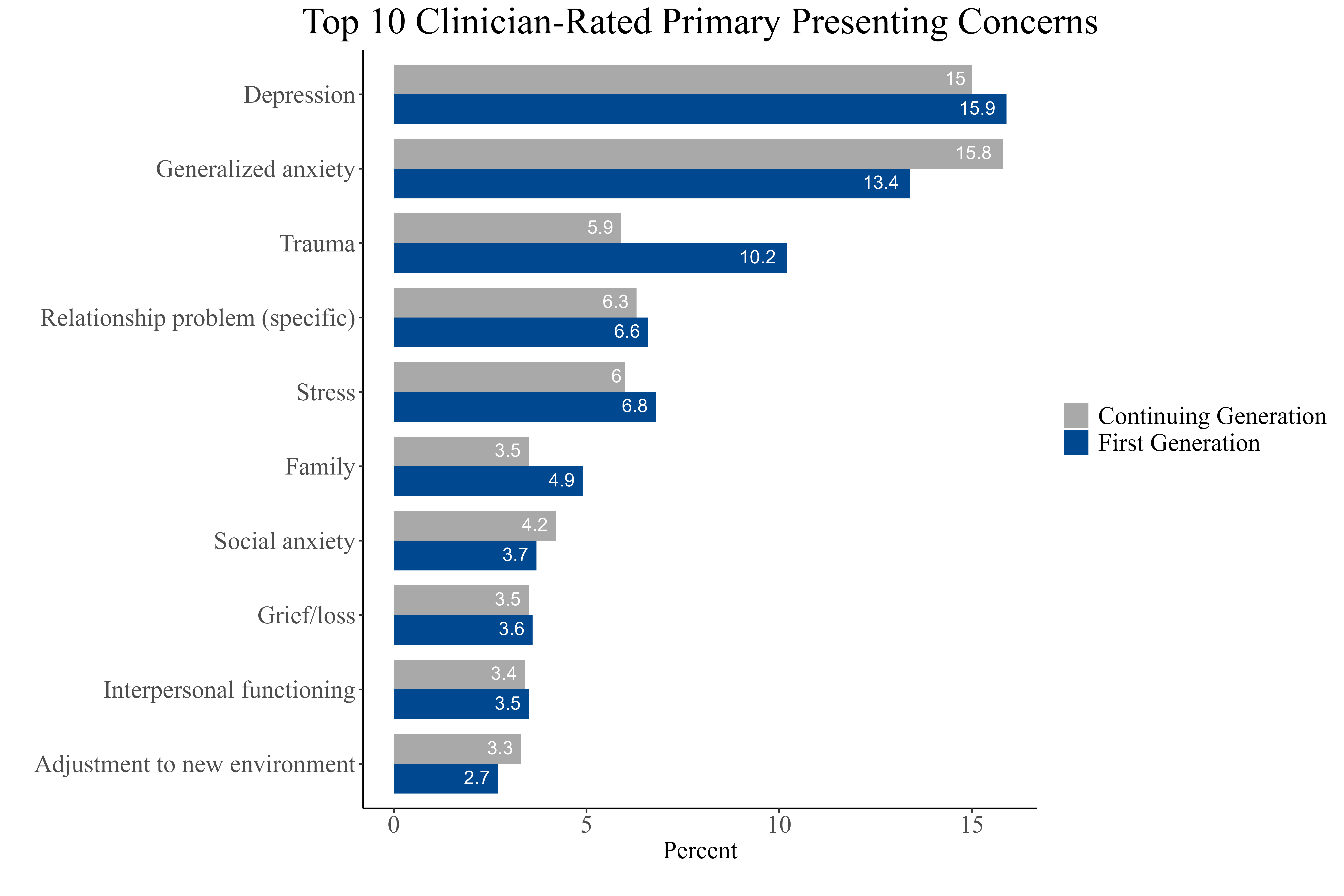
Mental Health Symptoms (First vs. Continuing Generation Students)
First-generation clients reported higher levels of general distress (Distress Index) than continuing-generation students when they initiated treatment. Moreover, they reported more symptoms of Depression, Generalized Anxiety, Social Anxiety, Academic Distress, Eating Concerns, and Frustration/Anger subscales of the CCAPS-34. However, they reported slightly lower Alcohol Use symptoms than continuing-generation clients.
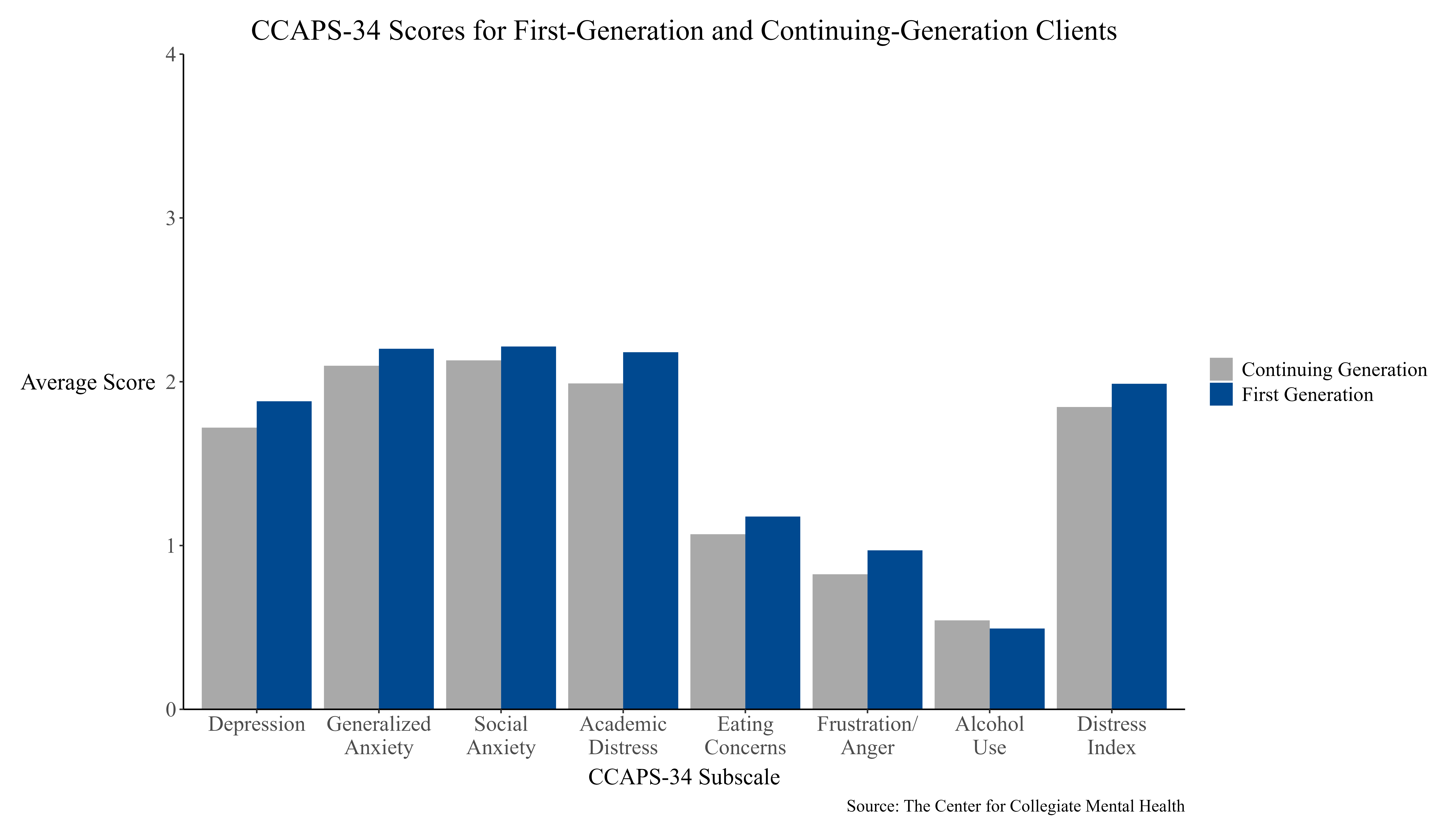
Summary
Takeaways
- As a group, first-generation clients are more diverse than continuing-generation clients in terms of race/ethnicity and sexual orientation, and they report higher levels of financial stress.
- There are some notable differences between first and continuing-generation clients in terms of their treatment histories and primary presenting problems. For example, first-generation clients are slightly less likely to have a history of outpatient mental healthcare but more likely to report past psychiatric hospitalization, and they are substantially more likely to have their therapist identify trauma- and/or family-related concerns at their top presenting problem.
- First-generation clients report slightly higher symptoms of distress on average at the beginning of treatment than continuing-generation clients. This pattern occurred across all domains of the CCAPS-34, with the exception Alcohol Use. Academic Distress was the area where first-generation clients demonstrated the greatest elevation of symptoms in comparison to continuing-generation clients.
Clinical Implications
- Due to the higher prevalence of marginalized social identities and financial stress among first-generation clients, clinicians are encouraged to use this information to inform discussions with clients how aspects of identity and financial status intersect with their first-generation college student experience (e.g., assessing the transition to college in terms of academic adjustment and potential cultural mismatch with peers). Doing so could help clinicians better understand their clients’ contextual experiences and formulate aligned interventions and recommendations. For example, some first-generation clients may benefit from referrals to adjunctive financial and diversity resources on college campuses.
- Compared to continuing-generation clients, first-generation clients have a higher prevalence of psychiatric hospitalization and trauma histories, as well as elevated distress across all domains of psychological problems except Alcohol Use. Because of these complex concerns, clinicians, counseling center leadership, and higher education administrators may best serve these first-generation students by implementing a multidisciplinary approach to care. For instance, therapists may need to more frequently discuss adjunctive medication referrals with first-generation clients to help address more severe or chronic concerns. Additionally, the findings highlight the importance of on-campus care for first-generation students, where counseling centers develop partnerships with other campus departments to provide more comprehensive support that addresses the higher rates of psychosocial and contextual challenges observed in first-generation students, including academic, financial, and family distress. Collaborations can include referrals and consultations with student disability services, need-based supports, financial literacy centers, family and parent programs, and academic support services. Academic institutions can encourage these efforts at an administrative level by providing personnel and financial support to campus offices that provide these necessary mental health and adjunctive support services to first-generation students.
References
Center for Collegiate Mental Health. (2024, January). 2023 Annual Report (Publication No. STA 24-147). https://ccmh.psu.edu/assets/docs/2023_Annual%20Report.pdf
Covarrubias, R., de Lima, F., Landa, I., Valle, I., & Hernandez Flores, W. (2021). Facets of family achievement guilt for low-income, Latinx and Asian first-generation students. Cultural Diversity & Ethnic Minority Psychology, 27(4), 696–704. https://doi.org/10.1037/cdp0000418
Ives, J., & Castillo-Montoya, M. (2020). First-generation college students as academic learners: A systematic review. Review of Educational Research, 90(2), 139–178. https://doi.org/10.3102/0034654319899707
Rockwell, D. M., & Kimel, S. Y. (2023). A systematic review of first-generation college students’ mental health. Journal of American College Health. Advance online publication. https://doi.org/10.1080/07448481.2023.2225633
Soria, K. M., Kelling, C., Mossinghoff, M., & Beahm, R. (2022). First-generation college students’ mental health during the COVID-19 pandemic. Journal of First-Generation Student Success, 2(2), 97-117. https://doi.org/10.1080/26906015.2022.2070442

